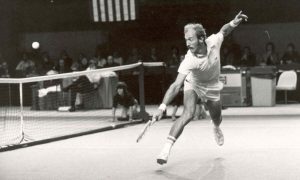Tennis, Fashion & Product Endorsement
An interesting piece popped up in the BBC around the time of this year’s Wimbledon Championships that shared a brief history, from hemlines to footwear, of the sport’s influence on fashion. In the midst of the US Open and in lieu of the recent tempest over the catsuit that Serena Williams wore to the French Open, which apparently didn’t sufficiently “respect the game” for Bernard Giudicelli, it seems an apt moment to reshare the BBC story.
The dialogue between tennis and fashion has existed for years. Take for instance adidas’ Stan Smith tennis shoe, which launched in 1971 after Smith won the US Open, and remains an iconic footwear within street fashion. In fact, the shoes were once listed in the Guinness Book of World Records after selling twenty-two million pairs as of 1988. Also establishing it as a point in case for product endorsement. Outside the realm of tennis, Nike’s deal with Michael Jordan is reportedly one of the biggest endorsement deals in history, with Nike alone said to spend $475 million annually on getting athletes to endorse their brand. Beyond sports, Beats by Dr Dre is a brand definitely not shy of celebrity marketing, which undoubtedly contributed to the brand’s massive success.

📷 Stan Smith in his prime (source unknown)
Brands didn’t miss the boat with this year’s US Open either, with adidas celebrating Billie Jean King with a limited edition AM4BJK SpeedFactory product drop. As adidas puts it: “uniting an iconic sporting legacy with technological innovation for today’s athlete”. The shoe has a particularly important message with it being part of growing efforts to keep girls in sport – with recent reports identifying girls in NYC as 1.5x less likely to play sport than boys. Needless to say, the shoe sold out in 17 minutes.

📷 adidas
What’s next?
It’s fair to say brand and product endorsement is a big thing – after Chanel signed Nicole Kidman in 2003, global sales of the promoted perfume reportedly increased by 30%. Nevertheless, it can also be said that as consumers become better educated and are granted faster access to information, blind faith in celebrity and influencer endorsements might not last forever. So, what comes next? adidas is a glowing example of a brand moving beyond endorsement towards artist collaboration – where influencers actually participate in the concept or design of the product that they are endorsing.
But brands will still need to provide tools to help consumers validate the individual fit of a product to their specific needs. This is how we work with brands like adidas to find new ways to engage and excite consumers. Like envisioning customization tools that give them opportunities to in turn co-create with favorite artists. Using real-time renderings, users can choose an artist’s specially designed pattern and apply it directly to their shoe. With ever extending patterns and artists, the opportunities to create shoes that users want to wear become endless. And where sportsmen and women were shaping the way, leading brands are now starting to encourage consumers to become co-creators and endorse their own designs.
In the next article in this series, we will take a closer look at front-runner brands who are leading the way in customization. To continue the conversation online and learn more about making all products playable digitally, please follow us on Twitter @INDG


